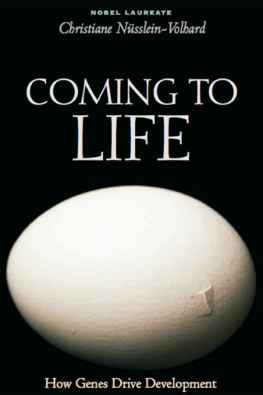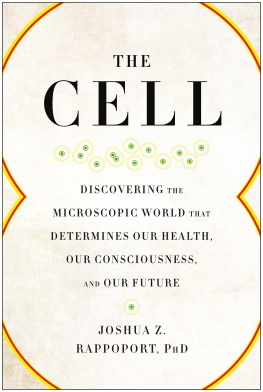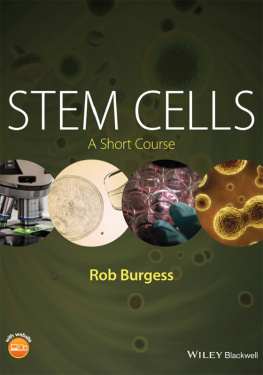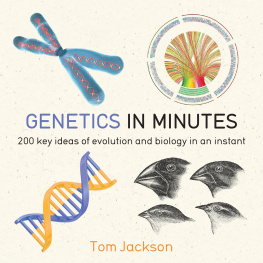
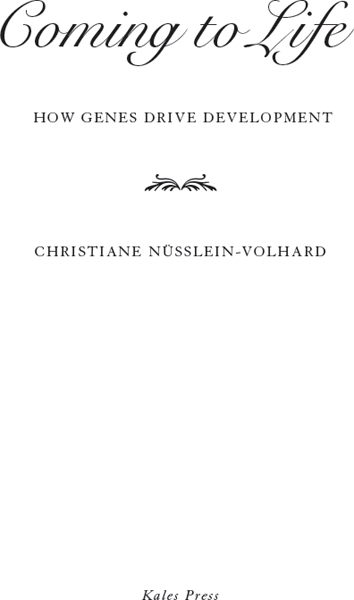
Every animal is an end in itself, it issues
Perfect from Natures womb and its offspring are equally perfect.
All its organs are formed according to laws that are timeless,
Even a form very rare will hold to its type, though in secret.
Johann Wolfgang von Goethe
Metamorphosis of Animals, 1806
THERE IS NOTHING MORE FASCINATING THAN LIFE. IT SEEMS A MIRACLE. FROM an eggthat is little more than a yolk sac protected by a thin shella walking, seeing, feeding chick develops. All it takes is a little time and the proper temperature. All living beings, including that chick and ourselves, are made up of nothing more than molecules, molecules consisting of atoms of different elements, most notably carbon, oxygen, nitrogen, and hydrogen. The structure of these molecules determines the way they react. The laws of physics and chemistry tell us that only chaos will develop on its own. And yet, in living beings order does prevail. So the question is: how does order prevail and, more importantly, how does order evolve in the first place?
Living beings are able to multiply themselves. This means that the organisms themselves are the blueprints for future generations. The nucleic acids that make up the genes provide the recipe for their own doubling. However, genes cannot replicate themselves on their own. Viruses, for example, are genes encased in protein. Yet they cannot be described as living things as they can only multiply in the context of a cell. Hence, cells, not genes, are the smallest units of life. Cells contain genes, but also harbor the building blocks and enzymes needed to multiply them. The genes provide the cell with a set of instructions that allow it to grow, to divide, to differentiate, and eventually, to build a new organism.
This book deals with the embryos of animals and their genes. How is it that an animal can develop from a fertilized egg that bore no resemblance whatsoever to it? What exactly is contained inside that fertilized chicken egg other than the nutrients providing the energy that, as the laws of physics and chemistry explain, are indispensable for the creation and preservation of order? What are the processes that lead to the development of cells of different types? And what is their characteristic succession that allows these processes to build a functioning animal that can feed itself? And finally, why do offspring look like their parents?
In the past 50 years, great strides have been made with regard to the understanding of these processes. The elucidation of the structure and function of DNA has made it possible to decipher genes and to understand the proteins they produce. The new science of molecular biology allowed not only the isolation of genes but also the visualization of their activity within a living organism. This development has brought us closer to solutions of problems that had previously been inaccessible. Answers to the mystery of how life develops now seem within closer reach than previously imaginable.
When I was a student, books of developmental biology were rather voluminous, full of highly complicated experiments pointing out so many trees that it was impossible to see the forest. Several contradictory theories and opinions stood against one another, and it was difficult to know what was important, what you needed to learn and remember, and what was prudent to forget. Today things are rather different as we have a widely accepted concept of genetics and development as a common denominator.
I have written this book for all those who are curious and who would like to understand the processes of life a little better without having to deal with highly specialized knowledge. It is for those who encounter biology in their professional life: medical professionals, chemists, and physicists. I hope my readership will also include those who might have many questions regarding genes and embryos owing to current bio-political debates, such as philosophers, lawyers, politicians, and theologians. Finally, while this work is by no means a course textbook, I believe that it may help teachers and students to fill the gaps and find connections between various disciplines.
My intention is to give a brief and concise overview without getting mired in the details. But the specialized terminology cannot be avoided altogether because the structures and molecules of organisms are not exactly the topics of everyday conversation. The glossary explains the more frequently used terms. The text assumes a basic knowledge of biochemistry and presents the concepts of cell biology rather briefly. We are not dealing with the attributes and characteristics of molecules so much as with their role in the development and preservation of complex shapes and forms. This very complexity creates the richness of all living things.
Explaining the mechanisms that lead to the development of patterns and forms is one of the main concerns of this book. Embryos develop through cell and molecular interaction in time and space. It takes patience to follow as more and more components get involved. The explanations of these processes have been simplified as much as possible and therefore may appear much simpler than they are in reality. Still, in order to enjoy a basic understanding of these processes not every detail is necessary. Broad strokes will have to do because life is complicated.
The text is arranged in chapters that are to some degree autonomous. The first chapter deals with the theory of evolution and provides a vital basis for an understanding of the larger context. This is followed by an introduction to the basics of cell and molecular biology. The main body of the book deals more specifically with the questions of how genes drive development and how form arises. Here I refer mainly to the fruit fly Drosophila as a test subject, as it, more than any other animal, has allowed for a relatively easy glimpse into the seemingly mysterious events of pattern formation. A further chapter reviews the most important processes of the growth and development of shapes and form on the cellular level. While portions relating to the development of vertebrates may be somewhat complex for the lay reader, this complexity is necessary for understanding the development of the human embryo. The final chapters discuss relevant topics of human biology and evolution, genome research, and bio-political questions. I hope the illustrations make these seemingly complex processes a bit more understandable.
For those of you who, after reading this book, would like to know more, I suggest referring to textbooks on the subject. Todays standard work is Molecular Biology of the Cell, compiled by Bruce Alberts and his colleagues. Weighing in at 1,500 pages, it is much more voluminous than this work, and yet still does not manage to cover everything. For texts that are more focused on embryonic development, refer to the books by Lewis Wolpert, Scott Gilbert, and Jonathan Slack. Also, John Gerhart and Marc Kirschner describe insightful aspects of the evolution of developmental mechanisms in Cells, Embryos and Evolution. Helpful illustrations of the anatomy of development can be found in Ulrich Drews Atlas of Embryology.
Finally, I would like to thank many friends and colleagues who have read, reviewed, critiqued, and encouraged this work at all stages. I have received many clarifications and suggestions that have served to improve my manuscript. Therefore, my sincerest thanks go to Christopher Antos, the late Jos Campos-Ortega, Darren Gilmour, Matthias Hammerschmidt, Dietrich Klose, Jana Krauss, Maria Leptin, Florian Maderspacher, Georg Otto, Siegfried Roth, Maria and Harald Schnabel, Frank Schnorrer, Anne Spang, Detlef Weigel, and Ernst Ludwig Winnacker. I also wish to thank Kenneth Kales for his patience and care in preparing the English version of my book for publication, and am indebted to Florian Maderspacher for his help with the translation.
Next page
